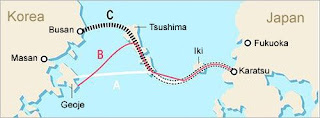The debate has raged for the past thirty years. Experts, nationalists and ordinary citizens on both sides of the Sea have offered supporting and dissenting research, projections, and opinions. Political posturing has overshadowed much of the debate as everyone imaginable has opined endlessly, questioning the feasibility of such a project. “Is it worth it?” “Will it be safe?” You name it, and it has been called into question. Well, it looks like those days are waning and, finally, plans are beginning to materialize and the question “Should Korea and Japan build a tunnel that links the two nations?” might just be answered.
In early January of this year, a research committee was tapped to start drawing up “specific construction plans” for the project. The proposed route would connect Geoje Island near Busan to Karatsu in northwestern Japan by an undersea tunnel (209km). It would be the longest undersea tunnel in the world and one of the most impressive engineering feats of the 21st century. (The Channel Tunnel is only 50km long)
For many Koreans though, the thought of such a connection invokes memories and emotions of a dark and violent past under Japanese colonial rule and under no circumstances would I ever suggest that those feelings are not justified. They are. This is understandably a very touchy and delicate issue which has clearly been reflected in its 30 years of rocky debate. I don't think comments like this are justified.
"...project's opponents say Korea would gain nothing from a tunnel, and it would only end up helping Japan advance into the continent. Choi Yeol, a professor of urban engineering at Pusan National University, said, "An undersea tunnel would add a Japan-size sphere of influence to the southeastern region of Korea. But Japan could extend its sphere to the Eurasian continent. That means the two countries would have disproportionate spheres of influence."I do think, however, that bridging the two nations would not only set a course towards a more trustful relationship between the old foes, but would also diversify South Korea’s economy, ease trade costs, tourist industry and improve its image around the world.
Some say the project carries a 200 trillion won price tag and, considering the state of the economy right now, even discussing such plans smacks of irresponsibility. Others point out the absurdity of building an undersea tunnel in a hotbed of seismic activity is enough to scrap the entire plan. Both of those points are valid and will need to be addressed, but if the project is deemed feasible and safe, the benefits severely outweigh the drawbacks.
South Korea has tried tirelessly to push their current “Korean Sparkling” tourism campaign. Seoul is getting facelifts and feverishly vying for a larger share of the northeastern Asian tourist industry, but is still seeing very little fruit for their troubles. The industry in essentially centered around Seoul and, for many reasons, is simply not attracting a substantial amount of non-Asian tourists.
As of now, Korea is locked in a battle of trying to prove itself as a world tourist destination which is clearly demonstrated by the slew of sales angles presented in their promotional commercials (here, here and here). The tunnel could potentially provide some direction. If the tunnel is built, Korea will no longer have to focus its resources on introducing Korea to the world’s tourists. Instead, they can appeal to the tourists who are already Korea-bound.
As we know, Japan is a well-established tourist destination and by easing access from Japan to Korea, it unlocks a passageway for tourists in Japan (as well as Japanese citizens) to come to Korea with little hassle. Not only would the headache and cost of air travel be eliminated, the lure of riding on the largest and most modern undersea tunnel would certainly be enticing enough that many tourists would certainly include a few days in Korea on their itinerary. And with the arrival city in Korea being somewhere other than Seoul, more opportunities for Korea to establish itself as a multifaceted tourist destination will be opened. Cities like Busan and Daegu will experience booms as well as smaller “unknown” cities all around the peninsula.
A properly managed influx of tourists is certain to have long-lasting effects on the nation’s image. This is one of the best ways Korea could maximize its exposure. By having a steady flow of tourists from around the world, Korea will have the opportunity to impress upon them just how modern, exciting and even business-friendly Korea has become. Gone will be the days when Korea must make its case as a vacation spot to the rest of world. All corners of the nation will become lively destinations and hotspots and as more people discover all that Korea has to offer, the government will finally start spreading its resources more evenly among its cities. Universities will open or move campuses, business would relocate their headquarters and finally Korea would become a country with more than one city.
The possibilities are endless and the advantages that Korea will receive from such a project would create positive ripples that none of us can fully predict. The battle ahead is still long and there will be a lot of political mudslinging and banter along the way, but I sincerely believe that Korea and Japan will come to an agreement, and that that will be a victory for this nation.
To be continued...






































